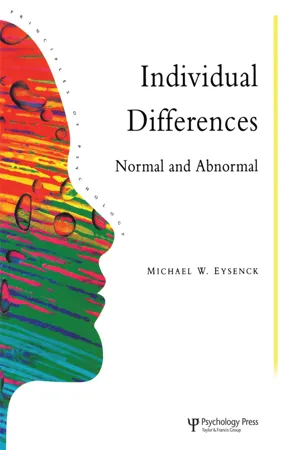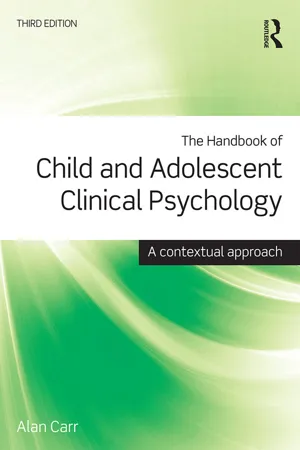Dispositional Factors
Dispositional factors refer to the individual's inherent traits, characteristics, and tendencies that influence their behavior and reactions in various situations. These factors are considered relatively stable over time and across different circumstances, and they play a significant role in shaping an individual's personality and overall psychological makeup. Examples of dispositional factors include traits like extraversion, conscientiousness, and neuroticism.
5 Key excerpts on "Dispositional Factors"
- eBook - ePub
- Donald Pennington(Author)
- 2018(Publication Date)
- Routledge(Publisher)
...In some ways this is part of the problem of which five traits should be in the big five. Different psychologists may come up with different names for the big five depending on how they see the cluster of traits produced by factor analysis. Finally, the dispositional approach is characterised as one producing numerous questionnaires to assess or measure personality. The question arises as to whether such questionnaires actually measure the dispositions they claim to measure, or whether the scores reflect how people respond to personality questionnaires. Because most use one or another type of self-rating scale, the psychologist has to assume that the person is answering honestly and openly. But this may not necessarily be the case and the responses people give could reflect a range of underlying motives. One of the most commonly recognised is that of social desirability – the wish to present yourself in a more socially desirable light than is actually the case. Some questionnaires, as we have seen with Eysenck’s, build in questions to check if a person is answering in such a way. If they are then the validity of all their responses comes into question. On a more positive note, the dispositional approach has been highly influential, especially in developing personality tests. Such tests, of which there are very many, have enjoyed widespread application in clinical areas and organisational psychology especially. 6.7 SUMMARY • Dispositions or traits are internal dispositions that are relatively stable over time and across situations. Dispositions are regarded as predictive of behaviour. Dispositions have most commonly been conceptualised as bipolar adjectives such as introversion–extroversion. Interest in describing behaviour using dispositions dates back to Ancient Greek times and Galen’s theory of the four humours...
- eBook - ePub
Individual Differences
Normal And Abnormal
- Michael W. Eysenck, University of London College(Authors)
- 2014(Publication Date)
- Psychology Press(Publisher)
...3 Personality: Factor theories What is personality? The concept of personality is one that has been defined in several ways in the history of psychology. However, a definition that captures much of what psychologists mean by personality was provided by Child (1968), who described it as “more or less stable, internal factors that make one person’s behaviour consistent from one time to another, and different from the behaviour other people would manifest in comparable situations” (p. 83). This definition is rather broad, because it includes intelligence as an aspect of personality. Many theorists argue that the term “personality” should be restricted to emotional and motivational factors, but others (e.g. Raymond Cattell) would extend it to include intelligence. As Hampson (1988) pointed out, the four key words in Child’s definition are “stable”, “internal”, “consistent”, and “different”. The whole notion of personality is based on the assumption that it is relatively stable or unchanging over time. Moods or emotional states may change dramatically over shortish periods of time, but personality does not. Because personality is internal, it cannot be equated with external behaviour. Instead, we use behaviour (e.g. restlessness; lack of eye contact) to draw inferences about the underlying personality. If personality is moderately stable over time, and if personality determines behaviour, then it follows that any given individual will behave in a reasonably consistent fashion on different occasions. Finally, those who study human personality are basically interested in individual differences. They assume that there are considerable individual differences in personality, and that these differences will be revealed by different ways of behaving in a given situation (e.g. in a social group, extraverted people will talk more than introverted people). It’s extremely important to note that explanations for individual differences in behaviour can take many forms...
- eBook - ePub
- Nisha Dogra, Brian Lunn, Stephen Cooper, Nisha Dogra, Brian Lunn, Stephen Cooper(Authors)
- 2017(Publication Date)
- CRC Press(Publisher)
...It is not feasible here to summarize the principal evidence for biological factors in all of the anxiety disorders. However, it is crucial to recognize that while many developmental, social and psychological factors are important we must remember that for many mental illnesses it is the interplay of all of these potential aetiological factors that is important – an interplay where the balance of each will differ from patient to patient. Psychological factors Individual personality traits and personality types are significant factors in the development of mental health problems. This encompasses temperament type, which is often used for children. The individual’s early development and attachment to carers may influence their ability to develop appropriate and meaningful relationships and may be significant aetiological factors. The developmental life stage that someone is at may also be an important factor. Personality types Temperament is used to describe the way individuals and especially children behave. It does not attempt to explain what causes the behaviour. Temperament is present from birth and influences how we behave towards people and how we see our environment. This helps understand why some individuals are able to manage many stressors whereas others develop problems in the face of what others may see as minor stressors. It is also important to note that our behaviour may lead others to behave in particular ways which may then establish helpful or non-helpful coping strategies. There is strong evidence that some temperament types in children, which become personality traits as they mature, are more strongly linked with some mental health problems than others. Problems in childhood are more likely when the child has a temperament that fits less easily with parental styles. In terms of thinking about personality types, it may be helpful to use the International Classification of Diseases (ICD) categories of personality disorder (Box 2.2)...
- eBook - ePub
The Handbook of Child and Adolescent Clinical Psychology
A Contextual Approach
- Alan Carr(Author)
- 2015(Publication Date)
- Routledge(Publisher)
...Such children are shy, timid and withdrawn in new situations. A higher proportion of youngsters with an inhibited temperamental style have parents with anxiety and mood disorders. This temperamental style is a risk factor for anxiety and mood disorders in childhood. Personality traits are enduring personal characteristics which influence behaviour, cognition and affect. Temperament and experience together provide a basis for the development of personality traits (De Pauw & Mervielde, 2010 ; Matthews et al., 2009). Through their interactions with parents, caregivers, teachers, peer groups and others, children with biologically based temperaments develop relatively enduring patterns of thinking, feeling and behaving. Certain traits render children vulnerable to developing psychological problems. For example, high levels of impulsivity may predispose young people to developing behavioural and substance use problems, while high levels of neuroticism may predispose children to developing anxiety, mood and eating disorders. Cognitive ability and beliefs about self-worth and personal control Certain personal psychological characteristics may render children vulnerable to developing psychological difficulties, notably limited cognitive ability or learning difficulties, negative self-evaluative beliefs and beliefs in personal powerlessness (Price & Zwolinski, 2010). Limited cognitive ability and learning difficulties as measured by IQ tests are risk factors for conduct disorders. Low self-evaluative beliefs as assessed by measures of self-esteem place children at risk for common psychological problems including conduct and emotional disorders, as well as other conditions such as eating disorders. Entrenched beliefs about having little control over significant aspects of one’s life (especially sources of reinforcement) are also associated with a range of psychological problems...
- eBook - ePub
- Robert J. Sternberg, Robert J. Sternberg(Authors)
- 2002(Publication Date)
- Yale University Press(Publisher)
...Even for these examples, situational as well as personality factors are important. Adaptive traits such as coping styles and wisdom clearly also make a contribution to quality of life, and study of these traits highlights the important role of thinking and social skills in dealing with life problems. The psychopathology of personality, to be considered in the following section, may be regarded as arising in part from a lack of such skills. Personality Disorders DEFINITION “Personality disorder” is defined in the American Psychiatric Association Diagnostic and Statistical Manual, DSM-IV (APA 1994) as “an enduring pattern of inner experience and behavior that deviates markedly from the expectations of the individual’s culture, is pervasive and flexible, has onset in adolescence or early adulthood, is stable over time, and leads to distress or impairment.” This definition makes explicit both the trait-like, persistent aspect of personality disorders (in contrast to the pattern of relapse and remission characteristic of clinical syndromes such as schizophrenia) and their maladaptivity. The negative consequences of personality disorder to the patient and to others can be envisaged by reference to the examples in Table 9.3A. Given that personality disorders are quite common (estimates vary between disorders in the range of 0.5 to 7 percent in the general population; Deary & Power 1998), it can be seen that these conditions are responsible for much distress and suffering. EXAMPLES OF PERSONALITY DISORDERS Little evidence suggests that patients with personality disorders differ in intelligence from the general population, with the exception of some indirect evidence for Antisocial personality disorder. This disorder is linked to criminal/delinquent behavior, which is in turn associated with below average IQ (McGarvey et al. 1981; Moffitt, Gabrielli, & Mednick 1981)...




